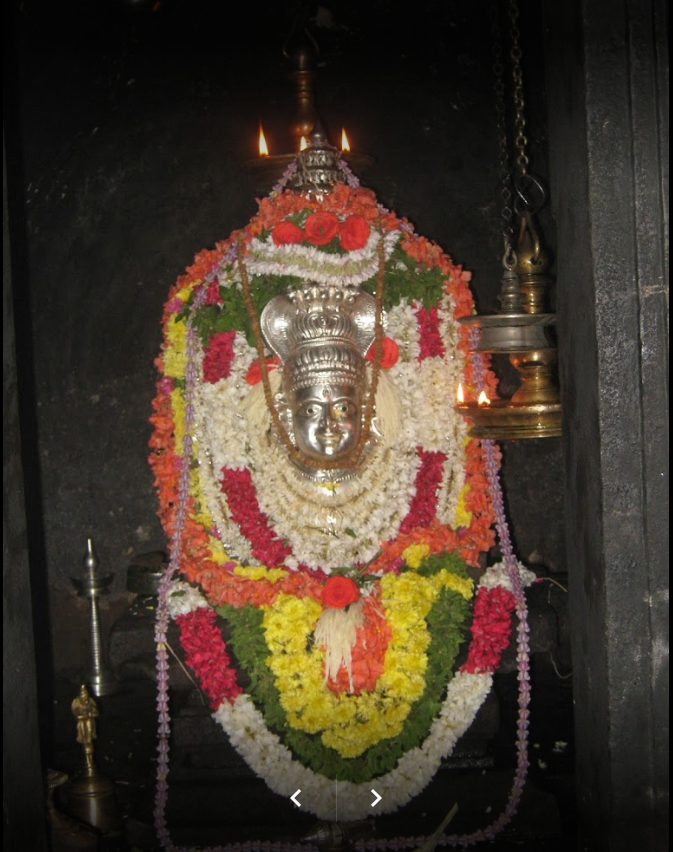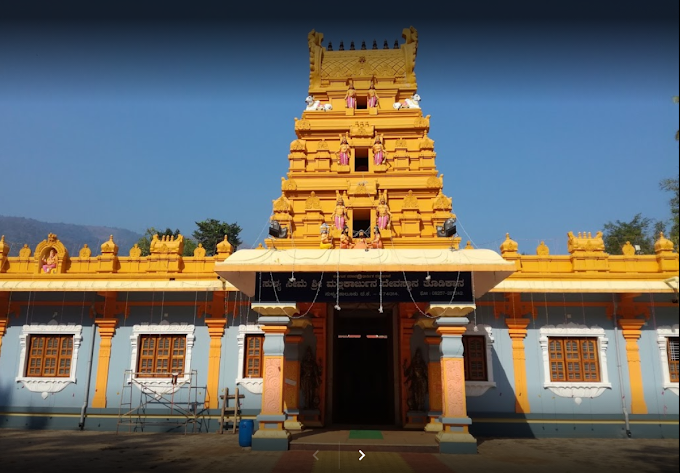About
Situated 33 kms from Panajim, Shree Shantadurga temple has an impressive idol of Goddess Shree Durga who mediated between Shree Vishnu and Shree Shiva and stopped the fiercefull war going on between the two. She is flanked by Vishnu and Shiva on both the sides.
The temples of Shree Shantadurga and Shree Mangesh, two of the most revered patron deities of the Hindu Goud Saraswat Brahmin community are located in Kavlem and Mangeshi respectively in the Ponda district of North Goa.
This avatar of Shree Jagdamba devi which had come to make peace [Shanti] between Shree Vishnu and Shree Shiva, came to be known as
Shree Shantadurga devi.
The original place of Shree Shantadurga devi was at Keloshi. From there devi was shifted to Kavlem during the rule of portuguese government.
This current temple structure of Shree Shantadurga devi was built during the period from 1713 a.d to 1738 a.d. Many renovations have been done over the years to the main temple and to the temples of other deities besides the agarshala [guest house] which is built on three sides of the temple.
History
Shree Shantadurga is one of the forms of Goddess Adimaya Durga. It is believed that once there was a fierce war between Lord Shiva and Lord Vishnu due to which the entire world was distressed. Hence Lord Bramhadeva prayed and beseeched Goddess Adimaya Durga to intervene and stop the war. The Goddess held Lord Shiva by one hand and Lord Vishnu by the other hand and brought about reconciliation among them. This stopped the war and brought peace to the world. This form of the Goddess Adimaya Durga, is known as Shree Shantadurga. In view of this background, in the Garbhagruha (sanctum sanctorum) of the temple, on either sides of the beautiful murti (idol) of Shree Shantadurga with four hands, there are small six-inch idols of Lord Shiva and Lord Vishnu.
Shree Shantadurga devi is both the wife and an ardent devotee of Lord Shiva. Hence it is imperative that while worshipping the Devi, Lord Shiva is also worshipped. In the temple's Garbhagruha near the Devi's murti a six-inch Shivalinga carved out of a black stone is placed. While doing 'abhisheka' (bathing of the murti) both the deities are worshipped together.
The original murti (image) of the Devi was stolen by Pathans from the temple during 1898 a.d . In 1901 a new murti was sculpted by Shri Laxman Krishnaji Gaitonde which was installed on Wednesday, the Phalgun Shukl Dashmi, Shake 1823 i.e. on 19 March 1902. And this murti is at its place till date. Till the new murti was installed, the murti of Shree Shantadurga was worshipped along with Shree Bhavanishankar by Shree Gaudpadacharya of Kavale Muth. All daily pujas were performed and festivals celebrated with this murti. On installation of the new murti, this murti has been placed in a cupboard-temple exactly behind the murti of Shree Shantadurga and is daily offered puja.
Due to the continuous abhishek and puja over the years, the shivalinga kept near the murti of the Devi had started wearing away in some places. Hence, after obtaining permission from Shree Shantadurga by way of prasad kaul, the job of sculpting a new shivalinga was assigned to the sculptor Shree Ramchandra Sunder from Mumbai. The new shivlinga was installed in the temple on Margshirsh Shukl Panchami 1887 a.d i.e. on 27 November 1965, among chanting of Vedas and Mantras. The old Shivalinga was submerged in the ocean in a religious ceremony.
The temple of Shree Shantadurga devi was originally at Keloshi. In Keloshi Shree Shantadurga Devi was known as Santeri devi and was worshipped by that name. Shree Shantadurga's temple was built at Keloshi by an affluent merchant, Anu Shenai Mone.
With the advent of the Portuguese in Goa and the increasing missionary activities, the community was afraid for the safety of the temples and idols. Hence the families worshipping Shree Shantadurga and Shree Mangesh, on a moonless night, leaving their homes and hearths behind crossed over the Juari river (also known as Aghashashini or Agashi river) with the images (murti) of the deities and the linga on their heads and shifted to the region under the rule of Muslim king Adilshaha. Via Dandi they reached the village Kavalem in Antruj village and chose a site with beautiful surroundings to install the image of Shree Shantadurga. It is indeed surprising that a new place could be found by the devotees for installation of Shree Shantadurga with exactly the same scenic beauty as available at Keloshi. The patron deity Shree Mangesh was installed in Priyol in Ponda Taluka. The place is now known as Mangeshi (its original name is not known though some believe that it was earlier known as Ganapati Wada). Antruj was too small a place to accommodate all the G.S.B.families who went there to escape the Portuguese harassment. They naturally dispersed in all directions but always regarded the temples as a link between them. Their voluntary contributions and later active patronage of Peshwas improved and enriched the temples.
There is some confusion regarding the exact date of shifting of these deities to a new place. However, as per the Portuguese records the deities were shifted sometime between 14 January 1566 and 29 November 1566. Shortly after shifting, both the original temples got demolished. Now the plot on which the original temple of Shree Shantadurga stood at Keloshi is known as "Deoolbhata" and it is in the possession of the temple trust. However, at Kushasthali it is believed that a Church stands in place of Shree Mangesh temple.
The village Kavalem belonged to the Harijan community. The people from the village were kind enough to provide a safe place for installation of the Devi. The idol of the Devi was installed in a small house in that village. After some time the house where the Devi was placed took form of a small temple and regular prayers were held in the temple.
The devotees of Shree Shantadurga did not forget the kindness shown by the Harijan community by providing a safe place for the Devi. All the people from the community were invited to the temple and were felicitated. This incident took place on Magha Shukla Shashthi day. Since then every year on the Magha Shukla Shashthi day the temple authorities invite the Harijans from the Kavalem and honour them by presenting them with Devi's saree, blouse piece, coconut, etc. This custom is being observed for the last four centuries without fail.
During those days, that part of Goa was ruled by a Muslim ruler, Adilshah and his representative for the area was a person called Sardesai, who belonged to the Saraswat community. This gave a sense of security to the community and patronage from the ruler for the temple. Shri Sardesai would always be present for the palkhi processions taken for the Devi. And slowly it became a custom to start the palkhi procession only in the presence of a member of the Sardesai family.
There are no records with the Temple trusties to indicate the exact time when the temple was constructed at the current location [Kavlem]. However, the records available establish that the current structure of the temple was in existence between 1713 A.D. and 1738 A.D. During the 20th century, the structure of the temple underwent repairs from time to time for maintenance and renovation.
The inspiration to build the temple was given by the Goddess (Devi) Shree Shantadurga to Shri Naroram Mantri. Shri Naroram Mantri was originally from Kochar village in the Vengurla region. His full name was Naroram Shenvi Rege and he was called Naroram Mantri as he was a Mantri [minister] in the Shahu Chatrapati's Court during the period 1723 a.d. He believed that he could attain the fame and fortune only because of the blessings of Shree Shantadurga devi. He felt that he should build a new temple for the Devi with his own money. He started building the temple building around 1730 a.d and with the help from other mahajans, the currently huge and beautiful temple was completed. Due to his efforts the village Kavalem was given as a gift to the temple by Shahu Maharaja in the year 1739 a.d . Shri Naroram Mantri also gave many donations to the temple. In view of his priceless contribution in making of the temple, Shri Naroram Mantri and his descendents are given the highest respect next to our Dharmaguru/Swamiji. His descendents get all the respect and facilities from the temple people and trust whenever they visit the temple. They have a reserved place in the temple for sitting during the pujas and arti. The place near the middle pillar on the northern side in the temple is reserved for this family. This pillar is called the Mantri Khamb [pillar]. For bringing them from their house to the temple, people with mashal (lighted torch) are sent. Also, any kind of musical program held in the temple in their presence is concluded only after obtaining their permission. His descendents also have the right to see the Prasadvastra of Devi [cloths offered to the Devi by the devotees] before leaving Kavlem.
Contact
Shree Shantadurga Saunsthan, Kavale, Ponda, Goa 403 401.
Devasthan Email: office@shreeshantadurga.com
Devasthan Telephone: (Off.) +91 832 2312557 & +91 832 2319900
Devasthan Mobile: +91 82750 11216















